SHORTCUTS TO EXERCISES
Split Stance Overhead Press | Lunge and Throw | Posterior Lunge and Press
From talk shows to infomercials to muscle magazines, everyone’s buzzing about the importance of core training. Strong core muscles not only look sexy, but they’re essential for transferring power from the lower to the upper body and boosting our performance in sports and everyday tasks. Plus, they keep us upright, help guard against hip and back pain, and improve our posture.
Most of us know we should regularly train our core, but we get mixed messages about how. Today, many trainers, exercise scientists and doctors are suggesting that we take less of our core-training advice lying down. Standing often works better, they say.
“Floor exercises like crunches don’t translate well to real-life situations,” explains William Gibbs, MD, medical director of the Department of Orthopaedics and Rehabilitation at The New York Hospital Medical Center of Queens. “Imagine moving a heavy box or hitting a tennis ball. You need to stand to recruit your core muscles most effectively.” Gibbs, a former bodybuilder, has his patients perform weight-bearing moves in the standing position so all of the muscles attached to the hips and pelvis get involved.
“Because we live, work and play upright, our nervous system understands that position best,” adds Todd Wright, CSCS, strength and conditioning coach for the University of Texas men’s basketball program.
That’s not to say all floor exercises are bad or that vertical core exercises are a brand-new concept. There are plenty of core exercises — planks and stability ball moves, especially — that recruit more muscles and translate better to real life than a simple crunch does. (For more on these, see “Core Essentials”.) And there are plenty of coaches and trainers who incorporate standing medicine-ball moves or borrow standing core exercises from dance training, for example, to help their athletes improve performance and reduce injuries.
What is new, Wright argues, is the concept of doing an entire core workout vertically in order to train every element of the core and give the feet, ankles, pelvis, ribs and thoracic spine as much play as possible.
With those goals in mind, Wright developed Vertical Core Training (VCT) for his basketball players and now teaches it to personal trainers, doctors and fitness buffs nationwide. “The key is to achieve tri-plane motion,” he says. Because we operate in 3D, we want our core to also move with strength through three planes of motion: frontal, sagittal and transverse, which encompass all the dipping, tilting and twisting our bodies do.
Since introducing VCT, Wright has noticed significantly fewer cases of lower-back pain, hernias and other core dysfunctions among his athletes, while seeing dramatic improvements in their overall power and performance. Best of all, he says, it’s something that will benefit any fitness enthusiast — beginner or pro.
Core Science
Before you launch into VCT, it helps to break down the concepts behind it. “When you understand why it works,” Wright says, “you’ll be more motivated to do the exercises.” Here are the basic tenets:
Everything’s attached. Wright’s initial inspiration in developing VCT was a desire to help athletes overcome lower-back pain. “I was having them do everything I could think of to help them strengthen the part of the body that was hurt — the lower back,” he recalls. But it wasn’t until he learned how the body works together as one unit that he realized that freezing parts of that unit to the floor — such as the pelvis or feet — can create imbalances in the entire chain.
It’s a simple anatomy lesson: The core muscles attach to the pelvis and under the rib cage. “I started to understand that if the foot isn’t mobile, the hip isn’t mobile, and then the pelvis, ribs and thoracic spine aren’t mobile,” he explains. Vertical Core Training involves the whole chain.
You need to move loads. In addition to the body’s anatomy, you have to consider the forces, or loads, we place on our body when we move. “There are three primary loaders, and the most important, in my mind, is the ground reaction,” says Wright. You have to push through the ground to create energy to move the body. Another loader is gravity. Any time you crouch or jump, you feel gravity acting on your trunk, pulling your body down like an invisible weight. The third primary loader is momentum. “Consider how you walk: Your arms swing, and that momentum creates a diagonal pull through your trunk.” Vertical Core Training incorporates these loaders for maximum benefits to the core.
Feet are important. There are 52 bones in the feet and only 206 bones in the entire body. “There are also 33 different joints and many muscles that attach there, making feet incredibly complex,” says Wright. “Every time your foot hits the ground, all those bones and muscles react, causing movement of the lower leg and then the femur, which connects to the pelvis, where all the core muscles attach.” Vertical Core Training, unlike other methods, keeps the feet directly involved by loading and unloading them through constant movement of the body.
The thoracic (middle) spine is key, too. “Thoracic mobility is unbelievably important in loading the core correctly,” Wright explains. Being active means moving your arms, and the arms drive the rib cage. “Every rib is attached to the thoracic spine,” he adds. Traditional “floor core” moves don’t allow for adequate movement of the thoracic spine, and that’s a big problem. (For more on thoracic spine mobility, see “Back in Trouble”.)
“As you perform some basic vertical core exercises (see “Stand Up for Your Midsection” below), you’ll become even more aware of how these elements all work together,” says Wright. You’ll develop a greater awareness of your body and how it moves in space, he adds, and prevent more injuries, too.
Vertical Core Training Exercises
Vertical Core Training is a series of exercises developed by Todd Wright, CSCS, strength and conditioning coach for the University of Texas men’s basketball program. Wright notes that lumbar mobility is not the goal. Rather, you want to get your pelvis, ribs and thoracic spine moving in three planes of motion while incorporating all the major body loaders — ground reaction, gravity and momentum. (Consult your doctor first if you’re suffering from a back injury, hernia or other injury.)
1. Split Stance Overhead Press

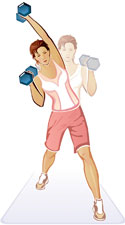
How-To:
- Stand in a split position with your right foot back and your left foot forward, legs slightly bent. Next, grip a lightweight dumbbell (3 to 5 pounds) in each hand, bringing them up to chest height, and then press them overhead one arm at a time — almost as if you’re punching the sky.
- Keep your feet in the same position, make sure you don’t lock out your elbows, and breathe deeply as you extend each arm and bring it back down (sagittal plane). Complete five reps per arm, then switch your feet so that the left foot is back, right foot forward, and complete another five reps.
- To add a little challenge, you can do a side bend during each overhead press, reaching one arm over the top of your head, and then the other (frontal plane). Next, reach each overhead press across your body (transverse plane) in an alternating fashion while still pressing the dumbbell overhead.
Core Benefit:
The motion of the overhead press drives the core to move in three dimensions, Wright explains. “You’re in the upright position, overcoming gravity. Your feet are on the ground, so you’re using ground reaction, and you’re using the momentum of the dumbbells above the head to extend the thoracic spine,” Wright says. By driving the dumbbells side to side, you also create a top-down force that causes the rib cage and pelvis to move, switching on all the muscles that connect your pelvis, rib cage and thoracic spine.
2. Lunge and Throw
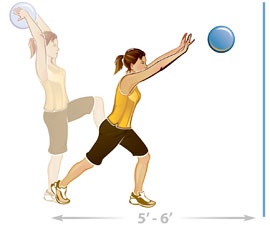
How-To:
- Holding a basketball, soccer ball or medicine ball, stand 5 or 6 feet away from a wall with your feet shoulder-width apart. Raise the ball over your head and lift your left foot.
- Lunge forward onto your left foot, throwing the ball forcefully against the wall so it comes back to you. Catch the ball as you push off your front foot and return to the starting position.
- Repeat, lunging forward with the right foot this time. Do 10 reps.
Core Benefit:
By lunging forward and back, you’re using ground reaction through your feet to drive energy through your body. The momentum of the lunge and the throw creates another load diagonally through the core. You’re also activating all the core muscles in your hips, ribs and pelvis.
3. The Posterior Lunge and Press
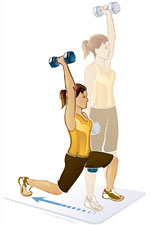
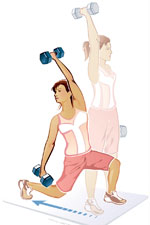
How-To:
- Begin with feet side-by-side, shoulder-width apart. Hold lightweight dumbbells (3 to 5 pounds) in each hand. Step backward with your right foot and complete an overhead press with your right arm at the same time.
- As you step forward to the starting position, press overhead with the left arm. Repeat for 10 reps, alternating feet and arms with each lunge. The next progression is to add a side bend (frontal plane) in the direction of your front leg as you step backward into the posterior lunge.
- The last progression is to reach each arm diagonally up and across your body (transverse plane) toward your front leg during the posterior lunge.
Core Benefit:
“The reaction of the pelvis is much different when you step backward rather than forward,” Wright says. “It spares the lumbar spine from stress, while also working the core.” Most people don’t extend through the hip very well, and this move can help, he explains. It creates more hip extension while working the core muscles through three planes, which translates to more flexibility and power.
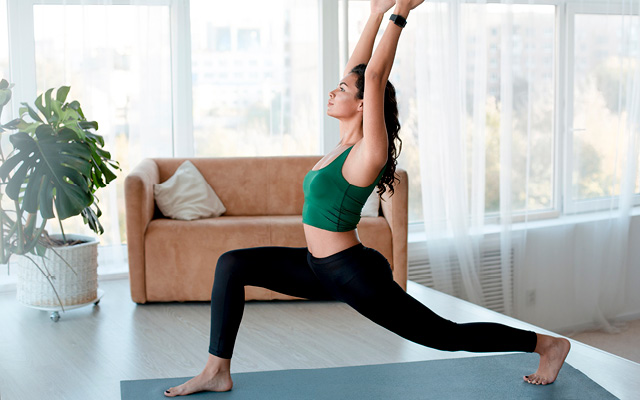
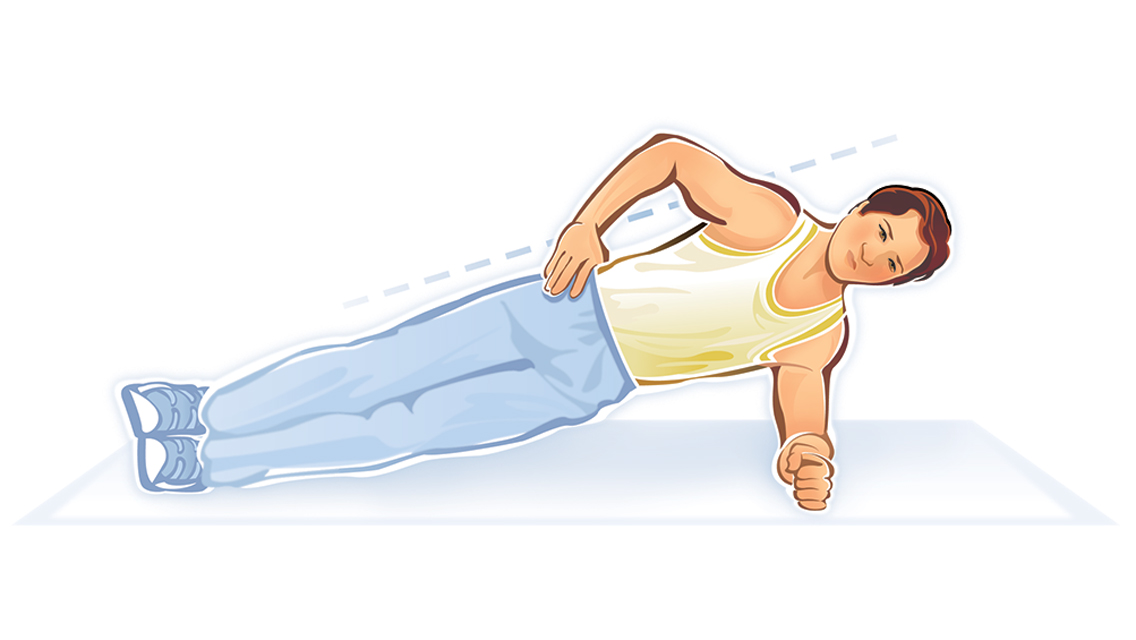

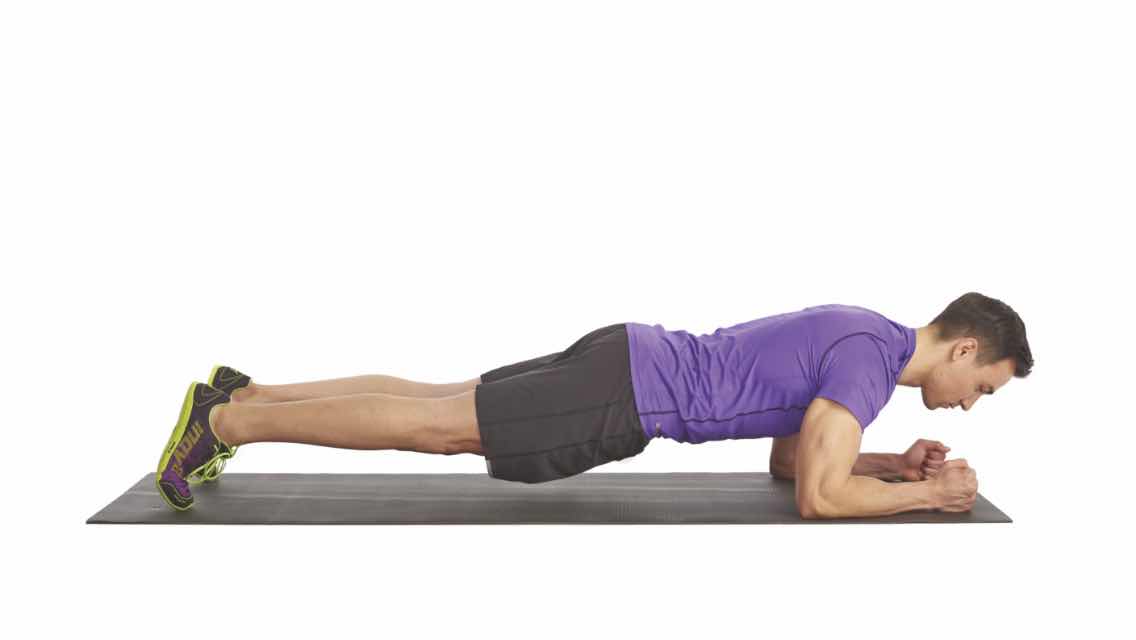
This Post Has 0 Comments